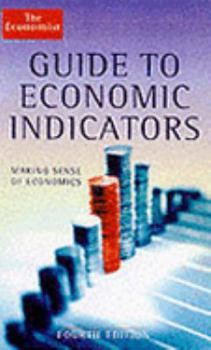The Economist Guide to Economic Indicators: Making Sense of Economics
Select Format
Select Condition 
Book Overview
This practical and invaluable reference for anyone in business (and for students) explains all the major and many lesser economic indicators. Included are the indicators that relate to: GNP and GPD... This description may be from another edition of this product.
Format:Hardcover
Language:English
ISBN:1861971834
ISBN13:9781861971838
Release Date:January 2000
Publisher:Profile Books Ltd
Length:240 Pages
Weight:0.95 lbs.
Dimensions:8.5" x 0.8" x 5.8"
Customer Reviews
5 ratings
Nice handy guide
Published by Thriftbooks.com User , 18 years ago
I wish I would have had it during Macroeconomics class for a reference.
A reference guide
Published by Thriftbooks.com User , 18 years ago
I expected a guide that would assist in determining where we were in the business cycle. This wasn't really it. The book is structured more like an encyclopedia - analyzing each indicator in detail and in isolation. A fine addition to anyone's economic reference books, but disappointed me by failing to treat the economy as an organic whole.
If only economics were that easy
Published by Thriftbooks.com User , 20 years ago
True to the style of The Economist, this book makes everything seem easier than it really is. However, for people who spend too much time thinking about economic issues, this is actually rather refreshing, much like a cold beer after a long day's work. Some examples: "In the long term, the growth in economic output depends on the number of people working and output per worker (productivity)" (Page 41); Or "In general, the more optimistic consumers are, the more likely they are to spend money. This boosts consumer spending and economic output" (Page 93)... ...One begins to yearn for the days where economics was more of an explanatory and less a mathematical science.The guide is divided into a number of chapters discussing issues and examples related to - How economic activity is calculated, and what the main indicators GDP/GNP/NNI capture and do not capture, as well as what changes in these indicators or their components mean. - Employment indicators such as employment by sector or the unemployment rate - Balance of payments and fiscal indicators, such as tax revenue or budget deficit - Consumer indicators, such as disposable income or consumer confidence and their significance - Investment and savings indicators, such as investment intentions or sales/inventory ratios - Business indicators, including business conditions, auto sales, construction orders and other common stats - Exchange rates and financial market indicators, such as interest rates and money supply. - Prices and wages, like the effect of oil price changes, among othersCoverage of the most common and widely available indicators is fairly comprehensive. Given the simplicity of the book, it is better to have a certain level of economic knowledge and opinion to be able to put the content in context. Not much different to reading The Economist, really.
A good reference guide for understanding economic indicators
Published by Thriftbooks.com User , 24 years ago
The book itself will be of great use for those analysts who evaluate country risk analysis. Economic indicators sometimes tend to be hard to understand, but this guide makes them easy to comprehend and relate to each other.
A good purchase
Published by Thriftbooks.com User , 24 years ago
As the title says, this book can help you make sense of economic indicators. The more you know, the easier it is for you to understand the economical aspects of society, and this seemed to add a lot more to my knowledge, and it clarified other thoughts.






